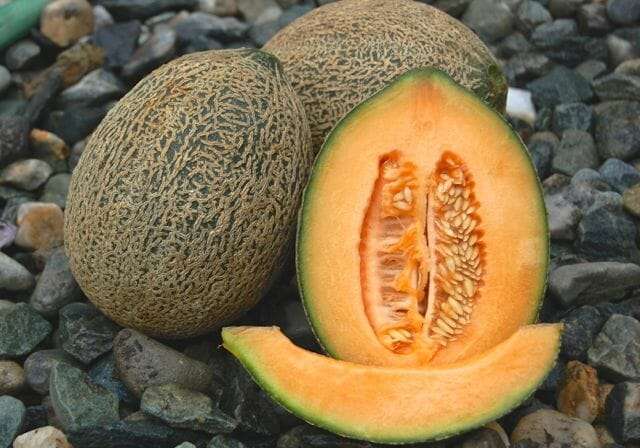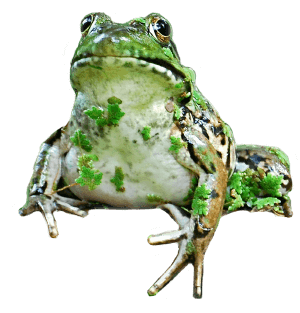how to grow melons (plus a podcast)
 HAS A JUICY, PLENTIFUL HARVEST of melons eluded you—perhaps because your growing season feels too short up North, or because powdery mildew attacked your plants in high summer, a challenge even in Southern, longer-season areas? How to grow melons: tips for success, in print and a podcast, too, with Tom Stearns of High Mowing Organic Seeds.
HAS A JUICY, PLENTIFUL HARVEST of melons eluded you—perhaps because your growing season feels too short up North, or because powdery mildew attacked your plants in high summer, a challenge even in Southern, longer-season areas? How to grow melons: tips for success, in print and a podcast, too, with Tom Stearns of High Mowing Organic Seeds.
how to grow melons
 THE KEY TO SUCCESS with melons wherever you grow them, say Stearns (left), a seed farmer who bravely raises both heirloom and hybrid melons successfully in Zone-4B northern Vermont, is getting them off to a strong start, and ripening them before the weather cools. Though his climate doesn’t provide it naturally, particularly in spring, Stearns simulates what melons want: an early start, consistent warmth, sufficient moisture—and the chance to finish their fruit in the heat, and also well ahead of the ravages of powdery mildew.
THE KEY TO SUCCESS with melons wherever you grow them, say Stearns (left), a seed farmer who bravely raises both heirloom and hybrid melons successfully in Zone-4B northern Vermont, is getting them off to a strong start, and ripening them before the weather cools. Though his climate doesn’t provide it naturally, particularly in spring, Stearns simulates what melons want: an early start, consistent warmth, sufficient moisture—and the chance to finish their fruit in the heat, and also well ahead of the ravages of powdery mildew.
Selecting a short-season variety, giving the seeds an indoor headstart of four or five weeks, then transplanting to a raised bed that was warmed up first with a mulch of black plastic puts melons on a path to success. Covering transplants with Reemay for the first four to six weeks outdoors is Stearns’s other key headstart tactic (details below, and in the podcast).
“It’s like they’re in their own little New Jersey,” the Vermonter says of his plants that are positively bursting to escape from the insulating fabric by the time he uncovers them a week or so after flowering begins.
Instead of a spindly little vine or two perhaps 1 to 2 feet long, Stearns says, melons given this extra protection may have as many as 10 vines 3 or 4 feet in length by the time they’re out from under cover to allow insect pollinators to do the melon-making. Sound good?
more melon-growing tips from tom stearns
- Choose shorter-season varieties, if that’s where you garden geographically. But if you are up North, be sure to adjust the days-to-harvest listed on seed packets, which are geared to Zone 6-ish conditions. “Those are days that are not northern-Vermont days—a 100-day variety might take 100 to 120 days in northern Vermont,” for instance.
- Growing short-season varieties can help both Northern and Southern gardeners alike. Even down South, where diminishing late-summer heat isn’t an issue, the shorter days-to-harvest means crops can finish before the costly mildew sets in, or before drought conditions intensify.
- Beat the mildew. But how does a foliar disease such as powdery mildew affect fruit? You may not see it on the melon, but don’t be fooled. What this disease is doing: “Sucking the sugar out of the melon to feed itself,” he explains.
- Don’t jump the gun on removal of the Reemay. Why not remove the Reemay at the sight of the first flower? “For the first 10 days with melon plants, all the flowers are males, so you’re not missing out on pollination,” he explains.
melon sowing-and-growing timeline
- Sow indoors under lights four or five weeks from your frost-free outdoor transplant date.
- Meantime, cover 3-foot-wide raised beds (where soil warms fastest) with black plastic.
- At transplant set-out time a month or so later, space hardened-off seedlings a foot apart, cutting holes in the plastic down the row. The plastic will also thwart weeds.
- Water in well, then tuck in the plants under a one-layer Reemay row cover.
- Leave the Reemay on until about 7-10 days into the plants’ flowering cycle, when it’s removed to allow pollination.
prefer the podcast?
HOW TO GROW MELONS was the subject of the March 18, 2013 edition of my weekly public-radio program, with High Mowing Organic Seeds‘ Tom Stearns as my guest. Tricks for outsmarting some common tomato diseases are also featured. Listen anywhere, anytime: Locally, in my Hudson Valley (NY)-Berkshires (MA)-Litchfield Hills (CT) region, “A Way to Garden” airs on Robin Hood Radio’s three stations on Monday about 8:30 AM Eastern, with a rerun Saturdays. It is available free on iTunes, the Stitcher app, or streaming from RobinHoodRadio.com or via its RSS feed. The March 18, 2013 show can be streamed here now. Robin Hood is the smallest NPR station in the nation; our garden show marks the start of its fourth year this month, and is syndicated via PRX.
(Photo of ‘Hale’s Best’ melon, courtesy of High Mowing Organic Seeds. Used with permission. Disclosure: A Way to Garden is proud to have High Mowing Organic Seeds as one of its seasonal advertisers.)





Great tips! What about the ravages of chipmunks, squirrels, and raccoons? ;)
I’m planting melons for the first time this year, so this was a very timely post! Thanks for all the great tips.
I have been growing my tomatoes staked in a row in a raised bed exactly as your guest described for three years now with great success. When first researched growing tomatoes I found this method on the web. It is called the “Florida weave” by most growers who apply it’s use. I adopted this method because I didn’t want to invest in cages. Staking was a much more affordable way to grow a large number of plants. I highly recommend it, it’s very easy. This year I will take Tom Stearns further advise and cover my raised beds with black plastic to warm the soil and further reduce the chance of disease. I am now also encouraged to find I may be able to grow melons! Great podcast, Margaret. Thank you.
We may give melons a try this year, thanks for the tips.
Thank you for this timely post (as it’s a blizzard outside!)
A wonderful farm south of me (Clearbrook ) uses reemay extensively, they are always moving covering and uncovering… I’m going to invest in that and more black (and red) plastic for another chance with getting a ripe (sweet ) melon
Thank you
Had the best melons ever last year and am hoping for more of the same this year. Live in the north and sure would like more summer but take what we can get. Thanks for the additional tips that will be helpful to me.
Rodney,
Feel free to stop by I am just getting started with humble beginnings.
Happy to “meet” you Rodney. If Tom can make melons “do” in Northern Vermont, I figure we all can! :)
Hi, Alan. They are my undoing (mentally and otherwise). you can net things (such as the fruit, specifically), or use a moveable electric fence kit (prestrung solar-powered plastic and cord low fencing) around the area.
I’m up in southern Ontario and this will be my first year trying to grow melons.
So far so good…. I have seeds going under lights, well little vines now. They are all doing well.
I have numerous raised beds and will try the black mulch (plastic) and the floating row cover for the melons.
This was a very timely article with great tips and hints.. Keeping my fingers crossed up here. Then who knows…. watermelons next?
One year long ago I grew some melons and they were the best I ever had. I have never been able to duplicate that experience. These tips make me hopeful that someday I might have my own melons again. They all make sense and are doable. Thanks!
Suellen
My issues with melons, particularly cantaloupe, stem from their flavor not being consistent and rain making them split. I get ripe melons every year, but they always taste different due to varying weather and soil conditions.
For the folks up north, I recommend Minnesota Midget as a musk melon and Blacktail Mountain watermelon. Both have been bred for northern gardeners.
Thanks Margaret! My kids got spoiled last year with the garden cantelope and now don’t wan the store bought ones. Kinda like the tomatoes from the grocery store in the winter! lol Have a great day! :)
Rodney
Being in the southwest of France, heat is never a problem, but mildew and split melons are. Stopping watering the plants about a week before full maturation seems to help (I also do a daily sniffing patrol around the melon beds to identify split melons and harvest them before the ants do) and as for as mildew, I have no solution for that as of yet except successive planting (which I can do in our long, hot growing season; I usually plant another crop about 2 weeks after the first).
I grew lovely melons the year before last that had absolutely no flavor or sweetness. They did, however, have powderly mildew by the end of the season. Apparently the mildew sucked the life out of them. Maybe I’ll be bold enough to try again some time. Thanks for the great information.
Will Reemay also keep the ” stink bugs” from killing your plants, over night ?
What do you do to keep them at bay ?
If we’re talking squash bugs and they’re overwintering in the garden, they’ll wake up under the Reemay I fear. Here are some articles I have written about them: How to ID, and how I tackle them, and why cleanup is so important.
I’m trying melons for the first time this year. Charentais, and Ananas D’Amerique A Chair Verte (what a name, lol). The Charentais is going in the ground, but the Chair verte is going on a trellis in a raised bed with the cucumbers. Both of these are small melons, perfect eating for one person. Friends of mine have had very bad fortunes with melons in Denver, but I’m hopeful!
Sarah’s Choice is my favorite cantaloupe. You can get the seeds at Johnny’s Seeds in Maine.
hi all..my sun melon is flowering now. Lots of males & only a female but, it is too skinny.Help! TQ
The’s plant’s too skinny? Did it reach for light (because it’s not in full sun) or is it in poor soil so it’s weak? Not sure I know what a sun melon is (a small Korean specialty like this, or a yellow watermelon, or ????).
i’m complete new to gardening. But if you use a black plastic cover, wont you have very hard time watering them, and when it rains wont the excess water forming on the plastic destroy the melons and vines?
Enough water seems to get through the X-shaped slits you make to plant the seedlings, and because the plastic hold moisture in, it also balances it that way (as if it’s a really thick moisture-retaining mulch). But you do need to have the open area — the X slits — by each plant. I haven’t had the other issue, which could be guarded against by the way the bed is mounded before the plastic is applied — to encourage runoff.